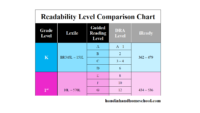Reading fluency – the ability to read quickly and effortlessly for meaning – is an essential step in the reading process. Through regular, daily practice, children move from sounding out letters to being able to automatically read whole words and sentences.
Knowing how fast your child reads is a quick check to see if your child is on track for a successful reading life. Decades of research have helped us understand the range of reading fluency skills kids have throughout kindergarten to high school. The chart on this page lists the standard reading rates for high – average – and low fluent readers, both in the beginning of the school year and after they’ve had a full academic year of reading instruction.
How To Calculate Your Child’s Reading Rate

- Select a passage of text your child has not read before.
Ideally, you’ll want to determine a separate reading rate for fiction text as well as fact-based text. You can use a textbook, a chapter book, or a child’s magazine article. - Count the total number of words in the passage.
Text should have between 100 – 300 words in it, depending on the age of the child. - Record your child reading a short passage of text.
Free downloadable cell phone digital recording apps include an automatic timer, which you’ll also need. You’ll use the recording to do a miscue analysis, afterwards. - Convert reading time into minutes.
If your timer only gives you total seconds, you’ll need to convert this into minutes. Divide the total time it took to read the passage by 60. For example, if it took your child 75-seconds to read the text, your math will look like this: 75 / 60 = 1.25 - Find your child’s Base Oral Reading Rate.
Divide the total number of words read by the time. For example, if your child read 146 words in 1.25 minutes, your math will look like this: 146 / 1.25 = 116.8 words per minute. This is your Base Oral Reading Rate. - Determine your child’s Silent Reading Rate
Simply repeat the above steps while your child reads the text silently to themselves. Begin timing the moment you uncover the text and you stop as soon as your child says done.
As the year progresses and your child builds their reading skills, Reading Rates will increase. Use this chart to check in throughout the year to see how your child’s reading skills progress.
Remember: A low Reading Rate in the early elementary grades DOES NOT automatically mean your child has dyslexia or a reading disability. A visit to your eye doctor to rule out vision problems and a review of the reading curriculum you are using are 2 first steps you can take to rule out other factors.
Last modified on September 28, 2019




